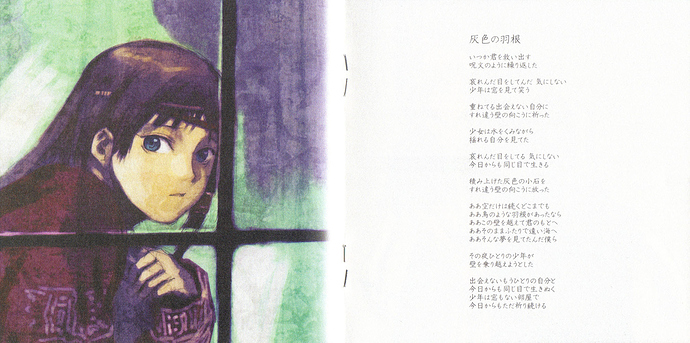Based on the translation provided in the topic, because I don’t know Japanese.
Title
“Grey Wings” reminds me of a fallen angel, in that their wings were once white but now they have greyed. Whether it was from corruption or exhaustion, the angel has somehow fallen from grace. Heart becoming “greyed” after the events of “Bokura no Koi,” the singer closes themselves from the world. The grey wings are the hopes the boy and the girl from the song share in coming together, wings to fly over the wall, grey because it is somewhat flawed.
Summary and Interpretation
I interpret the song to be the singer’s internal struggle to overcome something. Whether it’s to overcome rejection or the self-realization from “Bokura no Koi” they are figuratively and literally trying to overcome walls that encompass them. Outside the wall appears to be a girl. In terms of the song, the singer is trying to get to her.
Before I go and make generalizations, I’m going to try to define a few lines in terms of my interpretation.
The line “the girl, drawing water” refers to the girl’s painting from “Bokura no Koi,” and carries all meaning from it
The “wall” refers to the wall from Bokura no Koi that the singer and the girl were painting on, as well as a metaphorical wall.
Alright let’s go
“Someday I will save you” starts the song off strong. It shows the boy’s drive/dedication to the girl, and queues into how they will act throughout the song. The boy repeats it over and over, to reinforce the fact. In this line, we learn two things: the singer is omniscient, watching a boy and a girl, and the boy is driven to save the girl (perhaps obsessively so).
“Those eyes were pitying him” refers to people who are watching the boy, but who do they belong to? (I don’t know at this point)
What does have meaning is the part where “he doesn’t care.” In a later line, he takes interest in the girl’s eyes. This shows how he doesn’t care what others think, and is focused on his goal: the girl on the other side if the wall. He laughs in the face of the impossible challenge, and simply prays that he can meet her. On the other side of the wall, through a window, the girl is making “compassionate eyes.” This alludes to the fact that she also pities him, like “those eyes” do, but because it is her, he doesn’t care. Now, “he’ll live with the same eyes,” where they only see each other. This represents a connection formed between them (also mentioned in a later line).
Now we see from the girl’s perspective. “The stacked grey pebbles” seems to refer to the wall, but in such a way that it doesn’t seem like such a large obstacle. She doesn’t think that there is something big between them, and coming together can’t possibly be that hard. As she sees it, she only needs to wait for the boy to overcome it. She hits the wall in frustration, as if to send a message to hurry.
The next stanza could refer to the girl, or the boy, or both! Both makes the most sense because now that they share the same “eyes,” they share similar thoughts/motivations. The sky “continuing eternally” represents the space above the wall. The wall to sky ratio is small, so there is more space to get over it than it blocks the boy. They both wish for “wings like a bird” to “fly to your side.” The word choice “if only” sounds like something someone would say if they had given up. “If only I had wings” shows that they only have one solution in mind, and because people can’t grow wings(I guess that’s an assumption, kinda), the solution will never work. All they can do is hope that something will change to benefit them, but wishful thinking is not a solution. After wishing for wings, all they do is fantasize over the life they could share. “The two of us to the distant sea” refers to the future they could share together. The next line link their thoughts together further, saying “Ah, we saw such a dream.” That, along with the pattern of “ahs” makes me think that there is a connection to “Ao no Yume” here. The lines from both sections carry similar meaning, with the exception of Ao no Yume being more one sided. Does this mean that the boy and the girl see each other as the singer from Ao no Yume sees the “you” from that song? The song’s do follow a similar structure, someone wants to be with someone, takes action, fails somewhat, then vows to continue to work hard to find them.
Finally, the boy takes action. While he can’t grow wings, he can try to climb the wall. The final stanza shows us what happened to him. He never made it over the wall, and was put in a place where he can’t even see the girl(“room which doesn’t even have any window”). But from this place, he continues to live with the same eyes as her, and prays. He hasn’t given up hope.
The last stanza shows is that there external forces at work. Someone put the boy in a jail cell or something to prevent him from reaching the girl. The part about having no window is excessively cruel. On the figurative side, the boy must have tried to overcome the obstacle that prevented him from getting the girl (which I assume was the problem the singer had with themselves in Bokura no Koi) and failed in the process, achieving some deeper level of self realization, and falling deeper into their own flaws. Yet he still hasn’t given up.
Musical Analysis
What I find most important is where the violin swells. Towards the last line of the seventh stanza, it builds to a point, then the singer says “Ah, we saw such a dream.” It put a lot of significance on this line, and on their dream. It is the first line that mentions both the boy and the girl, and the first outright statement that they share the same dream (being together I guess).
Another interesting note is the maraca shaking sound, if anyone can figure out what it means when it plays.
Final Thoughts
I don’t really have any final thoughts, I just didn’t really enjoy this song. If I can think of any overarching meaning, it would be “never give up,” but that’s kinda obvious so I won’t go too deep into it.
I’m don’t really see how the song is about death, but the coffin interpretation and the Last Smile similarities are pretty cool. I can see how “drawing water” could be an IV (if the translation happens to make sense in that way).


